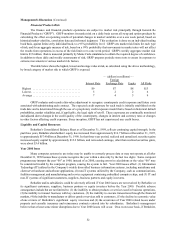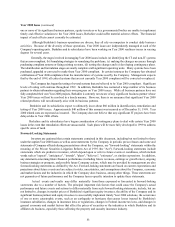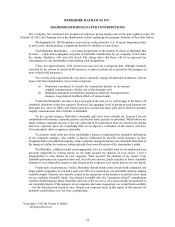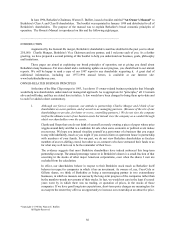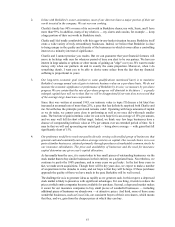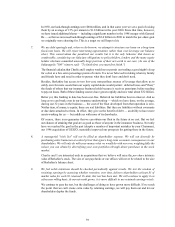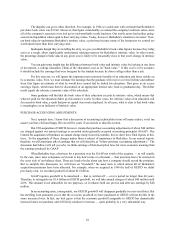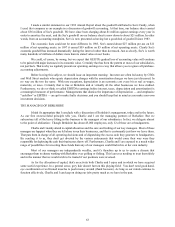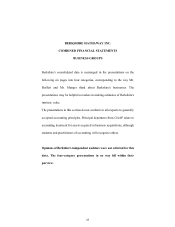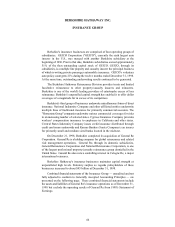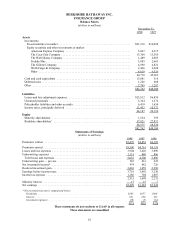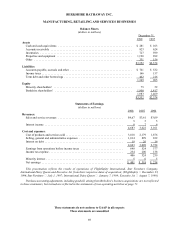Berkshire Hathaway 1998 Annual Report Download - page 60
Download and view the complete annual report
Please find page 60 of the 1998 Berkshire Hathaway annual report below. You can navigate through the pages in the report by either clicking on the pages listed below, or by using the keyword search tool below to find specific information within the annual report.59
In 1992, our look-through earnings were $604 million, and in that same year we set a goal of raising
them by an average of 15% per annum to $1.8 billion in the year 2000. Since that time, however,
we have issued additional shares — including a significant number in the 1998 merger with General
Re — so that we now need look-through earnings of $2.4 billion in 2000 to match the per-share goal
we originally were shooting for. This is a target we still hope to hit.
7. We use debt sparingly and, when we do borrow, we attempt to structure our loans on a long-term
fixed-rate basis. We will reject interesting opportunities rather than over-leverage our balance
sheet. This conservatism has penalized our results but it is the only behavior that leaves us
comfortable, considering our fiduciary obligations to policyholders, lenders and the many equity
holders who have committed unusually large portions of their net worth to our care. (As one of the
Indianapolis "500" winners said: "To finish first, you must first finish.")
The financial calculus that Charlie and I employ would never permit our trading a good night's sleep
for a shot at a few extra percentage points of return. I've never believed in risking what my family
and friends have and need in order to pursue what they don't have and don't need.
Besides, Berkshire has access to two low-cost, non-perilous sources of leverage that allow us to
safely own far more assets than our equity capital alone would permit: deferred taxes and "float,"
the funds of others that our insurance business holds because it receives premiums before needing
to pay out losses. Both of these funding sources have grown rapidly and now total about $32 billion.
Better yet, this funding to date has been cost-free. Deferred tax liabilities bear no interest. And as
long as we can break even in our insurance underwriting — which we have done, on the average,
during our 32 years in the business — the cost of the float developed from that operation is zero.
Neither item, of course, is equity; these are real liabilities. But they are liabilities without covenants
or due dates attached to them. In effect, they give us the benefit of debt — an ability to have more
assets working for us — but saddle us with none of its drawbacks.
Of course, there is no guarantee that we can obtain our float in the future at no cost. But we feel
our chances of attaining that goal are as good as those of anyone in the insurance business. Not only
have we reached the goal in the past (despite a number of important mistakes by your Chairman),
our 1996 acquisition of GEICO, materially improved our prospects for getting there in the future.
8. A managerial "wish list" will not be filled at shareholder expense. We will not diversify by
purchasing entire businesses at control prices that ignore long-term economic consequences to our
shareholders. We will only do with your money what we would do with our own, weighing fully the
values you can obtain by diversifying your own portfolios through direct purchases in the stock
market.
Charlie and I are interested only in acquisitions that we believe will raise the per-share intrinsic
value of Berkshire's stock. The size of our paychecks or our offices will never be related to the size
of Berkshire's balance sheet.
9. We feel noble intentions should be checked periodically against results. We test the wisdom of
retaining earnings by assessing whether retention, over time, delivers shareholders at least $1 of
market value for each $1 retained. To date, this test has been met. We will continue to apply it on
a five-year rolling basis. As our net worth grows, it is more difficult to use retained earnings wisely.
We continue to pass the test, but the challenges of doing so have grown more difficult. If we reach
the point that we can't create extra value by retaining earnings, we will pay them out and let our
shareholders deploy the funds.





